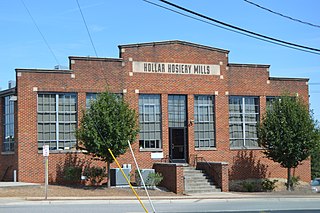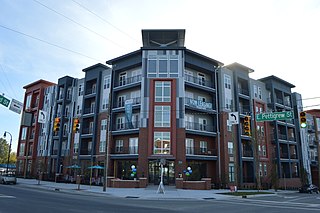
Mebane is a city located mostly in Alamance County, North Carolina, United States, and partly in Orange County. The town was named for Alexander Mebane, an American Revolutionary War general and member of the U.S. Congress. It was incorporated as "Mebanesville" in 1881, and in 1883 the name was changed to "Mebane". It was incorporated as a city in 1987. The population as of the 2020 census was 17,768. Mebane is one of the fastest-growing municipalities in North Carolina. Mebane straddles the Research Triangle and Piedmont Triad Regions of North Carolina. The bulk of the city is in Alamance County, which comprises the Burlington Metropolitan Statistical Area, itself a component of the Greensboro-Winston-Salem-High Point Combined Statistical Area. Two slivers in the eastern portion of the city are in Orange County, which is part of the Durham-Chapel Hill Metropolitan Statistical Area, itself a component of the Raleigh-Durham-Chapel Hill Combined Statistical Area.

Mock, Judson, Voehringer Company Hosiery Mill, also known as MoJud Hosiery Company and Rolane Factory Outlet Store, is a former hosiery production plant located at 2610 Oakland Avenue in Greensboro, Guilford County, North Carolina. The company was founded in 1926, and operated until 1972. The plant was then shut down, except for a small portion used as an outlet store, until its final complete shutdown in 1999. The plant was listed on the National Register of Historic Places in 2011.
The Oneida Cotton Mills and Scott-Mebane Manufacturing Company Complex, also known as the Scott and Donnell Mill, is a historic hosiery mill building in Graham, Alamance County, North Carolina. It consists of four contributing buildings and one contributing structure. The buildings date from 1882 into the 1940s; all are red-brick except for a small shed-roofed bathroom building from the 1940s. The complex includes the Scott and Donnell Mill, a smokestack (1882), Holt Mill, Scott-Mebane Manufacturing Company, and opener Room.

Garrou-Morganton Full-Fashioned Hosiery Mills, also known as Premier Hosiery Mills and Morgantown Hosiery Mills, is a historic hosiery mill complex located at Morganton, Burke County, North Carolina. The complex encompasses three contributing buildings and one contributing structure. They are the two Art Moderne style main buildings ; Outlet Store (1924) and Water Tower Structure.

The Lyerly Full Fashioned Mill is a historic hosiery mill located in Hickory, Catawba County, North Carolina. It was built in two stages between 1930 and 1934, and is a two-story, rectangular, nine-by-twelve bay brick building. It features a Moderne-Style 2 1/2-story stair tower. The mill remained in operation until 1957, after which the building was used as a warehouse for a number of years.

Hollar Hosiery Mills-Knit Sox Knitting Mills is a historic knitting mill located at Hickory, Catawba County, North Carolina. It consists of two mill brick manufacturing buildings and a boiler house that were connected by a hyphen in the mid-1960s. The first mill building was built about 1930, and is a one- to two-story, 16 bay, brick veneer structure. The boiler house was also built about 1930, and is a small, brick building, with its flat roof and terra cotta coping. The hosiery yarn mill was built about 1940, and is two-story, six bay by 10 bay, brick-veneered building. Both mill buildings feature banks of steel-sash factory windows. The knitting mill operated until 1968.

Whisnant Hosiery Mills, also known as Moretz Mills, is a historic knitting mill located at Hickory, Catawba County, North Carolina. It is a one- to two-story, trapezoidal shaped brick building consisting of contiguous sections built in 1929, 1937, the 1940s, the 1950s, and 1966. The mill closed in 2011. It was listed on the National Register of Historic Places in 2013. The property underwent significant rehabilitation using historic tax credits and re-opened as a mixed use space in April 2015. The property was designated a local historic landmark by the City of Hickory in August 2015.
Mor-Val Hosiery Mill, also known as Morris Mill, is a historic textile mill located at Denton, Davidson County, North Carolina. It was built in 1936, and is a one-story brick building consisting of a manufacturing area and office wing. It has a low-pitched roof and oversized windows. The mill remained in operation until about 1965.

Durham Hosiery Mill is a historic textile mill complex located at Durham, Durham County, North Carolina. It includes seven contributing brick buildings in the complex. The original Durham Hosiery Mill was built in 1902, and consists of a four-story main building with a six-story Romanesque Revival style tower in front; engine, boiler, and heater houses attached at the rear, and a one-story dye house. The main building was expanded with a two-story annex in 1904, and a three-story annex in 1906. Other buildings include the triangular Annex No. 1 (1912) and a three-story brick finishing building. By 1910, the Durham Hosiery Mills Corporation was the largest manufacturer of cotton hosiery in the world. The mill was abandoned in 1922.

Durham Hosiery Mills No. 2–Service Printing Company Building was a historic textile mill building located at Durham, Durham County, North Carolina. It was the remaining section of a one-story brick building constructed by the Durham Hosiery Mills Corporation in 1916. The other section was destroyed by a fire in 1979. It featured tall segmental arched windows, heavy exposed curved rafter ends in the eaves, and a monitor roof. After 1947, it housed the Service Printing Company.

Durham Hosiery Mills Dye House is a historic textile mill building located at Durham, Durham County, North Carolina. It was constructed by the Durham Hosiery Mills Corporation in three sections between 1920 and 1921. They are the boiler room, office / warehouse, and dyeing area. It is constructed of exterior reinforced concrete bearing walls, steel trusses and a heavy timber structural system.

Shamrock Mills, also known as Hanes Hosiery Mill #1, is a historic textile mill building located at Winston-Salem, Forsyth County, North Carolina. It was built in 1911, and is a one-story brick building with daylight basement. It is six bays deep and extends in seven sections with a rhythmic saw-tooth roof and six-foot skylights. An addition was built in 1925. It was the first building used by the Hanes Hosiery Company. The mill closed in 1926, and the building subsequently housed a Cadillac dealership. The building houses the Sawtooth School for Visual Art.

P.H. Hanes Knitting Company is a historic textile mill complex located at Winston-Salem, Forsyth County, North Carolina. The complex includes three buildings. The Knitting Building or North Building was built in 1920–1921, and is a six-story, Beaux-Arts style concrete and steel building sheathed in brick. The Mill Building or East Building was built in 1928, and is a five-story-plus-basement building of concrete, brick, and steel construction. The Warehouse and Shipping Building was built in 1940, and is a six-story steel frame building sheathed in brick. The P.H. Hanes Knitting Company was founded in 1901 by Pleasant H. Hanes, brother of John W. Hanes who founded Shamrock Mills, later Hanes Hosiery. In February 1965, P. H. Hanes Knitting Company merged with Hanes Hosiery. The downtown mill complex closed in 1965. The complex has been converted to loft apartments.
Belmont Hosiery Mill was a historic textile mill building located at Belmont, Gaston County, North Carolina. The original section was built in 1945–1946, and was a two-story-on-basement brick mill building. In 1952, a two-bay-deep, two-story-on basement addition was built and in 1958, a two-story-on-basement rectangular addition was built and features Art Moderne detailing. In 1969, a roughly "U"-shaped two-story-on-basement addition was built at the rear of the mill. A small one-story loading dock addition completed around 1998. The mill closed in 2000. The mill has been demolished.

Grey Hosiery Mill, also known as Water Department-City of Hendersonville and Hold Hosiery, is a historic textile mill located at Hendersonville, Henderson County, North Carolina. It was built in 1915, with additions in 1919 and 1947. It is a one-story, brick building with large multi-pane steel sash windows and stepped gable roof with clerestory. The mill closed in 1967.

Eureka Manufacturing Company Cotton Mill, also known as Tait Yarn Company and Lincoln Bonded Warehouse Company, is a historic cotton mill located at Lincolnton, Lincoln County, North Carolina. It was built between 1907 and 1910, and is a two-story, brick factory building with a three-story stair tower. Adjacent to the factory is a two-story brick office building built between 1902 and 1906. The buildings housed the Eureka Manufacturing Company from 1906 to 1937, and Tait Yarn Company from 1949 to 1966. Lincoln Bonded Warehouse occupied the buildings into the late-1990s. The buildings are owned by the Lincoln County Historical Association.

Acme-McCrary Hosiery Mills, also known as Acme Hosiery Mills, McCrary Hosiery Mills, and Asheboro Grocery Company, is a historic textile mill complex located at Asheboro, Randolph County, North Carolina. The complex includes six buildings and a smokestack, erected between 1909 and 1962. The mill buildings were designed by architect Richard C. Biberstein and the oldest section is a two-story, heavy-timber-frame mill with load bearing brick walls. The Acme-McCrary-Sapona Recreation Center was built in 1948–1949, and is a two-story, Art Moderne style brick recreation center. The buildings were added to the National Register of Historic Places in 2014.

Stephenson Underwear Mill is a historic textile mill located at South Bend, St. Joseph County, Indiana. It was built in 1916, and is a three-story, rectangular, nine-bay reinforced concrete building with brick curtain walls. It features a parapet with concrete coping and concrete panels on each side of the front panels. The building was rehabilitated for use as apartments in the early-1990s.

The Fitchburg Yarn Mill is an historic mill building at 1428 Main Street in Fitchburg, Massachusetts. Built in 1907 and enlarged several times, it was one of the city's largest textile operations for over 60 years. The building is an important local work of Frank Sheldon, a noted industrial architect of the period. The building was listed on the National Register of Historic Places in 2016.

May Hosiery Mills Knitting Mill is a historic building that was built as an early 20th-century hosiery knitting mill in Burlington, Alamance County, North Carolina. Built in 1928, it is listed on the National Register of Historic Places.




















